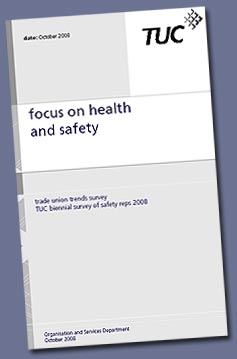 |
 |
|
TUC's Focus On Health & Safety Biennial Report Available
The TUC have issued the full report and an exective summary which details the major areas of concern. Detailing the main hazards, the summary states: Once again overwork or stress was by far the most frequently identified hazard, with no sign of improvement in most workplaces. Three in five (60%) of safety representatives identified overwork or stress as a concern, similar to the previous survey and higher than in earlier surveys.
Display screen equipment was the second most-quoted concern and has risen from fourth in 2004 and third in 2006. This year over two in five (41%) safety representatives identified it as a hazard - significantly more than in the previous surveys. HSE has done little work on the issue in recent years. Musculoskeletal disorders (MSDs) are still a major hazard in workplaces and the situation appears to be getting worse again after some improvement in 2006. Two-fifths of representatives (40%) identified repetitive strain injuries (RSI) as a major concern, while over three in ten (31%) saw back strain as a problem. RSI was the third most identified hazard and back strain fifth - a continued cause for concern given the emphasis HSE has placed on reducing these injuries.
Slips, trips and falls on a level was the fourth most significant hazard identified - and again the picture is worse than in recent years. Around a third (33%) regarded it as a major cause for concern, up from 27% in 2006. Working alone was the sixth main concern - with more representatives (30%) identifying it as a hazard compared to previous surveys. Bullying was perceived as a growing hazard, recognised by 20% of representatives. It was identified by 40% more representatives compared with 2004 and by 25% compared with 2006 - indicating that employers' voluntary initiatives are not reducing the problem. The survey suggests that bullying gets worse as the workplace gets bigger. Some 14% of representatives thought bullying was a problem in workplaces with under 50 employees, while almost double (27%) saw it as a concern in workplaces with over 1,000 employees. Wales was the place with the most concerned regionally. It is the area most concerned with noise (23%), dusts (16%), infections (7%), asbestos (7%) and vibration (6%). In these cases, almost twice the proportion of Welsh safety representatives were concerned, compared with the national average. Wales is also second worst for slips, trips and falls from a level (38%), long hours of work (26%), handling heavy loads (16%), chemical and solvents (15%), slips, trips and falls from height (12%) and machinery hazards (11%). The summary also details the main problems regarding management of health and safety in the workplace: Over half (55%) of the safety representatives in the 2008 survey said their employer had carried out adequate risk assessments, though this was down slightly from the highpoint in 2006, where (56%) said risk assessment were adequate. An increased proportion of safety representatives in 2008 said that their employers' risk assessments were inadequate. Three in ten (30%) of representatives came to that conclusion, compared with 27% in the last survey. In terms of consultation over risk assessments:
The survey found a big increase in the proportion of occupational health services provided externally, and for the first time is greater than those provided in-house. Some 46% said their occupational health service came from an external provider, compared with 44% in-house. By comparison, in 2006 some 38% were externally provided, whilst 48% were provided in-house. A number of sectors were significantly worse off than with regard to occupational health services. Less than three in five (59%) construction safety reps said their employer provided an occupational health service, down from around four-fifths (79%) in the last survey. Similarly, leisure services had less than three-quarters (73%) covered, and distribution, hotels and restaurants 78%. More safety representatives are reporting sickness monitoring (68%) and disciplinary assessments (43%) than previously, indicating a more draconian approach by some employers. The provision of treatment has also fallen to around one in five workplaces (21%) and first aid now appears in only half (50%) the workplaces surveyed, despite the legal requirements to do so. And records are still provided to only one in eight (12%) safety representatives, indicating wide scope for improved information and consultation. The report can be downloaded from the TUC website here |
